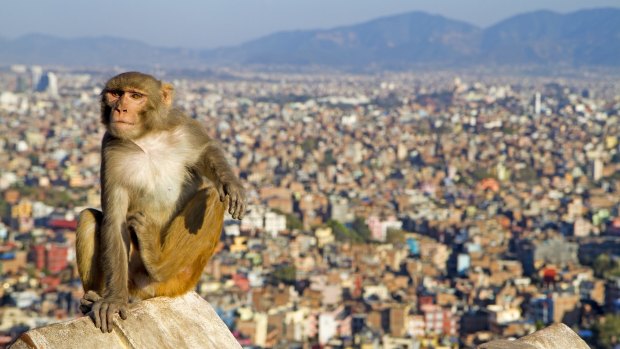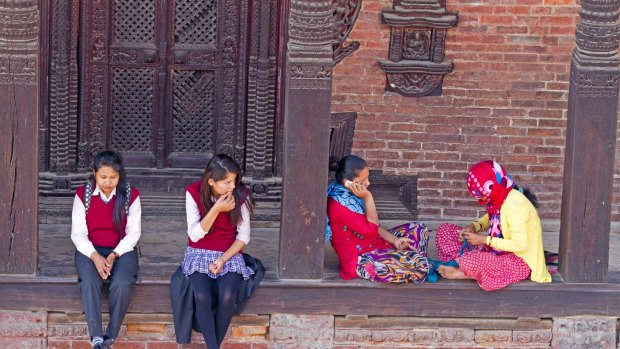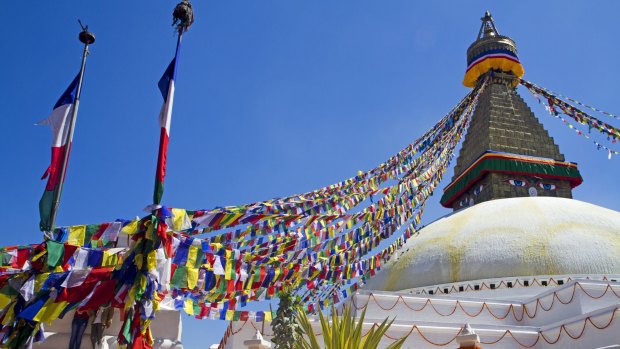This was published 10 years ago
Kathmandu: the city with the most UNESCO World Heritage sites
By Andrew Bain

Rhesus macaque on the walls of Swayambhunath,the so-called Monkey Temple overlooking Kathmandu.Credit: Andrew Bain
Think of the world's great cities and Kathmandu is not an obvious contender. But search through the chaos of the ever-growing city and there's one trait in which the Nepali capital is streets ahead of the likes of Paris, New York and Tokyo.
Kathmandu has more Unesco World Heritage sites than any other city in the world. Seven internationally recognised cultural treasures dot the city and its satellite towns, making it a place that's more than just a gateway to the trekking trails of the Himalayas.
Befitting a city that's a melange of religions, Kathmandu's two most striking World Heritage sites represent different faiths: Hinduism and Buddhism.

Local women and school girls hanging out on the steps of a temple in Bhaktapur's old town.Credit: Andrew Bain
Pashupatinath is the holiest Hindu shrine in Nepal and the oldest-known temple to Shiva in the country, though most visitors don't come just to see a temple. Pashupatinath sits on the banks of the Bagmati River, which flows into the holy Ganges River, and cremation ghats line the river through the temple area. Each day, around 40 bodies are cremated here, with their remains swept into the river, destined for the Ganges.
It's a place where life meets death head-on. Visitors, mourners and brightly adorned sadhus – their hands out both in blessing and for cash – all mingle on the banks in scenes that make death seem more everyday than funereal. Pyres are built on the ghats, with relatives of the deceased feeding the flames with straw, wood and the occasional bit of rubbish. Smoke sits over the complex and there's invariably the unmistakable smell of bodies aflame; life literally going up in smoke.
About two kilometres from Pashupatinath, Boudhanath Stupa is the grandest Buddhist statement in the country of the Buddha's birth. Hundreds of prayer flags hang like pigtails from the stupa, and the painted eyes of the Buddha on the four sides of the stupa seem to look out over the entire city. Buddhists believe the remains of Kassapa Buddha, the third Buddha of bhadrakalpa, were enshrined in the stupa when it was built perhaps as early as the fifth century AD.

Boudhanath Stupa. Credit: Andrew Bain
The 36-metre-high, whitewashed stupa is the largest in Asia, and it's the epicentre of Nepal's Tibetan refugee population, with 41 Buddhist monasteries surrounding the enormous structure. Visitors, pigeons and dogs mill among the monks and pilgrims as they complete their ritual perambulations, spinning the prayer wheels along the stupa's base as they go. The faithful will circuit the stupa 108 times, a distance of around five kilometres.
It's typically busy and peaceful at once; a place that hums with the sound of chants, singing bowls, spinning prayer wheels and the footsteps of pilgrims.
There's another pilgrimage of sorts each sunset to Swayambhunath, the so-called Monkey Temple perched on a hilltop inside the city. This World Heritage-listed complex incorporates the oldest stupa in Nepal and a range of temples that blend Buddhist and Hindu design.
Swayambhunath is reached up a steep set of 300-plus steps (or taxis can deliver you to the top). Once inside, it's like a scale model of Boudhanath, with a marginally smaller stupa ringed with prayer wheels.
Monkeys dart about the slopes and scamper along the walls, seemingly enjoying the views over the city as much as the temple's visitors. From here, Kathmandu looks like Lego blocks scattered through the valley, and it's the city's viewpoint of choice as the sun rolls behind the hills at the end of each day.
Through the Kathmandu valley there are three Durbar (Palace) Squares, dating back to times when Nepal was 24 kingdoms rather than one country. Kathmandu was part of the Newar kingdom until 1768, when the country was unified, and a vast royal area was created at its heart – now the World Heritage-listed Durbar Square. Other Durbar Squares, also on Unesco's list, were built by the Newar royals in Patan and Bhaktapur, adjoining towns now swallowed up inside the sprawl of the capital.
Kathmandu's Durbar Square is as busy as the city itself, but in the one-time Newar capital of Bhaktapur, things run at a different pace.
Bhaktapur's square is just one part of an old town that's a virtual living museum. Overlooking an archipelago of squares are multi-tiered temples and palaces with the most intricate of carvings, ranging from the sacred to the sordid. Buildings slump with age, and the cobblestones are as worn as Nepal's history. The grandest of the palaces surround Durbar Square, but through the old town every lane and square has a personality of its own. It's relaxed and vibrant at once, a place that feels deserving of the world's heritage attention.
Trip Notes
MORE INFORMATION
GETTING THERE
Thai Airways flies daily to Kathmandu from Melbourne and Sydney, transiting in Bangkok. thaiairways.com.
World Expeditions runs dozens of trekking trips through Nepal, typically with visits to Pashupatinath and Boudhanath Stupa while in Kathmandu. worldexpeditions.com
STAYING THERE
The Radisson Kathmandu offers central accommodation across two buildings, and includes the likes of a day spa and rooftop pool. radisson.com
The swanky, sprawling Hyatt Regency is just a few hundred metres from Boudhanath Stupa. kathmandu.regency.hyatt.com
The writer travelled courtesy of World Expeditions.
Sign up for the Traveller Deals newsletter
Get exclusive travel deals delivered straight to your inbox. Sign up now.